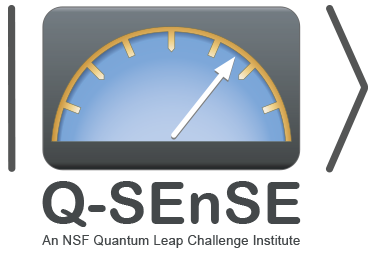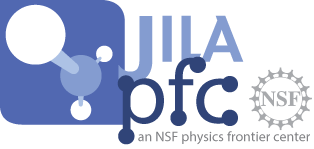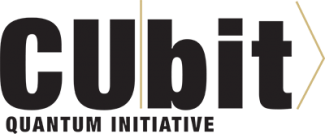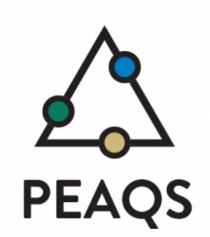 Q-SEnSE: Quantum Systems through Entangled Science and Engineering (top)
Q-SEnSE: Quantum Systems through Entangled Science and Engineering (top)
In the Q-SEnSE institute, prominent quantum researchers in experiment and theory, science and engineering, from around the U.S. and internationally, collaborate to explore how advanced quantum sensing can discover new fundamental physics, develop and apply novel quantum technologies, provide tools for a national infrastructure in quantum sensing, and train a quantum savvy workforce.
Background: U.S. National Need
The United States has placed quantum information science (QIS) at the top of its science and technology agenda with an unprecedented investment in research to ensure that the U.S. maintains and advances its global leadership in this emerging technological arena recognized for its economic impact and importance to national security. The National Strategic Overview for Quantum Information Science mirrors similar significant investments in the U.K., Europe, China, Canada, and Australia.
The urgency of U.S. interest in QIS is motivated by a realization at the highest levels of government, industry, and academia that the nation faces a significant risk of falling behind global competitors in this area, with corresponding lost opportunities and increased threats to our national security, economy, and workforce. This situation is historically unique because the laws of quantum mechanics dictate the limits of what is possible at the most fundamental known level, differing in character from earlier revolutions dependent on the limits of thermodynamics (steam engine), bulk materials (wired communications), or semiconductor gate densities (computers).
 JILA Physics Frontier Center (top)
JILA Physics Frontier Center (top)
The JILA Physics Frontier Center (JILA PFC) brings together 20 investigators in collaboration to share goals, ideas, expertise and technology in their aim to realize precise measurement, innovative manipulation, and harvesting ever-more intriguing meaning, all in the world of complex quantum systems. A theme that runs through all of JILA PFC research is the importance of interactions in understanding and exploiting the nature of quantum many-particle systems.
Background: An NSF Physics Frontier Center
The Physics Frontiers Centers (PFC) program supports university-based centers and institutes where the collective efforts of a larger group of individuals can enable transformational advances in the most promising research areas. The program is designed to foster major breakthroughs at the intellectual frontiers of physics by providing needed resources such as combinations of talents, skills, disciplines, and/or specialized infrastructure, not usually available to individual investigators or small groups, in an environment in which the collective efforts of the larger group can be shown to be seminal to promoting significant progress in the science and the education of students. Activities supported through the program are in all sub-fields of physics within the purview of the Division of Physics: atomic, molecular, optical, plasma, elementary particle, nuclear, particle astro-, gravitational, and biological physics. Interdisciplinary projects at the interface between these physics areas and other disciplines and physics sub-fields may also be considered, although the bulk of the effort must fall within one of those areas within the purview of the Division of Physics. The successful PFC activity will demonstrate: (1) the potential for a profound advance in physics; (2) creative, substantive activities aimed at enhancing education and public outreach; (3) potential for broader impacts, e.g., impacts on other field(s) and benefits to society; (4) a synergy or value-added rationale that justifies a center- or institute-like approach. (Download the whole PDF document)
Website: https://jila-pfc.colorado.edu
 STROBE (top)
STROBE (top)
The STROBE Science & Technology Center is a collaborative exchange between six universities across the United States to advance imaging science and technology and build the microscopes of the future. STROBE aims to transform imaging science and technology of functioning nano-systems by creating powerful and broadly-applicable real-time nano-to-atomic scale imaging modalities. This technology addresses global grand challenges in science and technology, while building a strong, diverse, STEM workforce.
Background: An NSF Science & Technology Center
The Science and Technology Centers (STC): Integrative Partnerships program supports innovative, potentially transformative, complex research and education projects that require large-scale, long-term awards. STCs conduct world-class research through partnerships among academic institutions, national laboratories, industrial organizations, and/or other public/private entities, and via international collaborations, as appropriate. They provide a means to undertake significant investigations at the interfaces of disciplines and/or fresh approaches within disciplines. STCs may involve any area of science and engineering that NSF supports. STC investments support the NSF vision of creating and exploiting new concepts in science and engineering and providing global leadership in research and education. Centers provide a rich environment for encouraging future scientists, engineers, and educators to take risks in 1 pursuing discoveries and new knowledge. STCs foster excellence in education by integrating education and research, and by creating bonds between learning and inquiry so that discovery and creativity fully support the learning process. (Download the whole PDF document)
Website: http://strobe.colorado.edu
 CUbit Quantum Initiative (top)
CUbit Quantum Initiative (top)
In response to both national needs and the rapid advance of quantum information science and technology (QIST), JILA is helping CU Boulder to design and establish the new CUbit Quantum Initiative, along with Physics, Engineering, Chemistry and several campus Centers. CUbit will advance fundamental science and build a strong foundation for novel QIST technologies and their rapid dissemination, application, and commercialization.
CUbit research will explore the broad areas of Quantum Sensing and Metrology, Quantum Networks and Communications, Quantum Matter and Dynamics, and Quantum Computing and Simulation, with parallel emphasis on Industry Engagement and Education and Workforce Training.
To optimize its approach of “Best science, fastest pace, greatest impact”, CUbit will seek to partner with predominantly regional universities, National Labs, and NIST Boulder.
Website: http://colorado.edu/CUbit
 PEAQS (top)
PEAQS (top)
The Partnership for Education and Advancement in Quantum and Nano Systems (PEAQS) is a program funded in 2018 by the National Science Foundation Partnerships for Research and Education in Materials (PREM) program. PEAQS is led by Fort Lewis College (FLC) in Durango, CO, together with Norfolk State University (NSU) in Norfolk, VA, and the STROBE NSF Science and Technology Center for Real-Time Functional Imaging headquartered at JILA at the University of Colorado Boulder. The goal of PEAQS is to enhance the education, research, and career preparation experiences in material and imaging science for undergraduate students in traditionally underrepresented populations. PEAQS creates a diverse and inclusive community that focuses on cutting edge material science that explores the multi-scale interplay of atomic and meso-scale structure and emergent physical phenomena. Each institution brings their own strengths to the table to accomplish this goal. STROBE is a cutting-edge imaging science and technology center committed to broadening participation in STEM, NSU is a Historically Black University that has world-class capabilities in material growth and synthesis, and FLC is a Native American-Serving, Nontribal Institution that offers the expertise and infrastructure for material characterization and nanofabrication. Together, we are creating exciting applications that attract a diverse group to STEM; novel and effective curricula and pathways that recruit and retain the best in STEM; and long-term assessment to improve our strategies and share best practices.
 Center for Theory of Quantum Matter (top)
Center for Theory of Quantum Matter (top)
The Center for Theory of Quantum Matter (CTQM) conducts theoretical physics research focused on macroscopic quantum matter. This research area is a focal topic that transcends traditional discipline boundaries, unifying the otherwise disparate fields of condensed matter physics; atomic, molecular and optical (AMO) physics; nuclear physics; high energy physics; and quantum information science. CTQM aims to leverage and develop the unique, broad-based strengths in these areas at CU Boulder, with the aim of becoming a recognized world leader in theoretical quantum matter research. The multidisciplinary nature of the research makes the establishment of CTQM crucial to achieve this aim. CTQM is housed in the Department of Physics, with strong ties to JILA and NIST.
Website: http://ctqm.colorado.edu
 MID-IR MURI (top)
MID-IR MURI (top)
MID-IR MURI titled “Harnessing Strong-Field Mid-Infrared (IR) Lasers: Designer Beams of Relativistic Particles and THz-to-X-ray Light”. MURI is part of a new class of MURIs awarded in 2016.
Our evolving understanding of strong-field laser-matter interactions has led to a revolution in optical science. The high harmonic generation process makes it possible to generate coherent, laser-like, beams X-rays on a tabletop by harnessing the quantum dynamics of laser-driven electrons. Laser-particle accelerators exploit colossal electric fields in plasmas to produce quasi-monoenergetic ion, electron, and hard X-ray beams. Finally, nonlinear interactions can guide intense laser light energy over extended distances.
Website: http://jila.colorado.edu/muri


 The Physics Frontiers Centers (PFC) program supports university-based centers and institutes where the collective efforts of a larger group of individuals can enable transformational advances in the most promising research areas. The program is designed to foster major breakthroughs at the intellectual frontiers of physics by providing needed resources such as combinations of talents, skills, disciplines, and/or specialized infrastructure, not usually available to individual investigators or small groups, in an environment in which the collective efforts of the larger group can be shown to be seminal to promoting significant progress in the science and the education of students. PFCs also include creative, substantive activities aimed at enhancing education, broadening participation of traditionally underrepresented groups, and outreach to the scientific community and general public.
The Physics Frontiers Centers (PFC) program supports university-based centers and institutes where the collective efforts of a larger group of individuals can enable transformational advances in the most promising research areas. The program is designed to foster major breakthroughs at the intellectual frontiers of physics by providing needed resources such as combinations of talents, skills, disciplines, and/or specialized infrastructure, not usually available to individual investigators or small groups, in an environment in which the collective efforts of the larger group can be shown to be seminal to promoting significant progress in the science and the education of students. PFCs also include creative, substantive activities aimed at enhancing education, broadening participation of traditionally underrepresented groups, and outreach to the scientific community and general public.